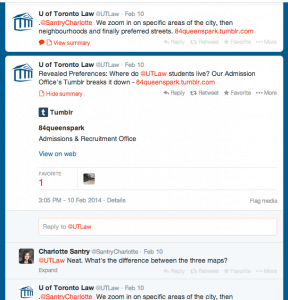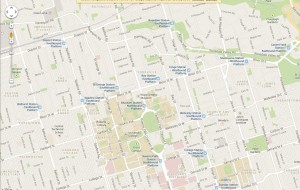
Earlier this month student outrage erupted over a Faculty of Law blog post that featured a map of where current students are living in Toronto.
The entry, titled “Revealed preference 2: the immediate area”, was posted by Associate Dean Ben Alarie to the Faculty of Law’s tumblr on February 4. The post included a Google map of Toronto with many pins identifying specific points. Several students noticed pinpoints on their exact residences.
Alarie says the map was intended to give incoming students a sense of where current students choose to live. The map was not interactive and did not include the names of any students or any specific addresses.
On February 10, the Faculty of Law tweeted a link to the post to their over 8,000 followers. The tweet has since been deleted.
A concerned alumnus sent Alarie an email around 1:30 a.m. on the morning of Thursday, February 13. The offending blog post was taken down by 5:30 a.m. on the same day.

Alarie insists students have nothing to worry about.
While he would not agree to a recorded interview, Alarie sat down with UV and explained that the pins only represented postal codes, not specific addresses. He added that the map only included information from a sample of UTLaw students and that no students could be identified from the information posted.
On February 13, the administration posted a new entry on their tumblr, explaining that they removed the map to address student concerns. The entry notes in bold that “no student personal information was ever made public.”
Many students were not convinced. Several students approached UV and said that pins were located exactly on their houses.
Part of the problem may be that downtown Toronto has some of the smallest postal codes in the country. Some have a radius of only 20 meters. Apartment buildings often have their own postal code.
Genevieve (1L) told UV that a pin was located directly on her house. She says she is concerned by the administration’s approach to students’ personal information.
“I realize that they associated no names with the addresses. That is not the point,” explained Genevieve. “The point is that my personal information is being put to a very unorthodox purpose, which I did not have in mind when I consented to give it. If this information is being treated so trivially, in such an open fashion, how am I supposed to trust that my information is being protected or confidential in other contexts?”
Aurora (2L), expressed concern over student safety:
“Having spent eleven years as a police officer before coming to the Faculty of Law, I found this map of student addresses to be cause for safety concerns. The Faculty is small, and this map is, not to put too fine a point on it, a stalker’s dream.”
When asked about the issue of women feeling concerned about the posted information, Alarie responded: “I understand the concern. I have trouble imagining how it would play out [in terms of the information being misused].”
Alarie underscored that the Faculty took down the post within hours of hearing students complaints and reiterated that the school takes student privacy very seriously.
“We thought hard about whether particular students could be identified,” he said.
The administration says they did not consult any students or the SLS before posting the map.
“We don’t consult the SLS about posts we make on the admissions page,” said Alarie.






